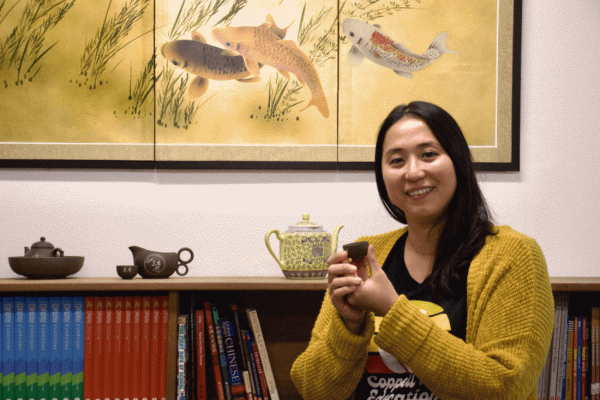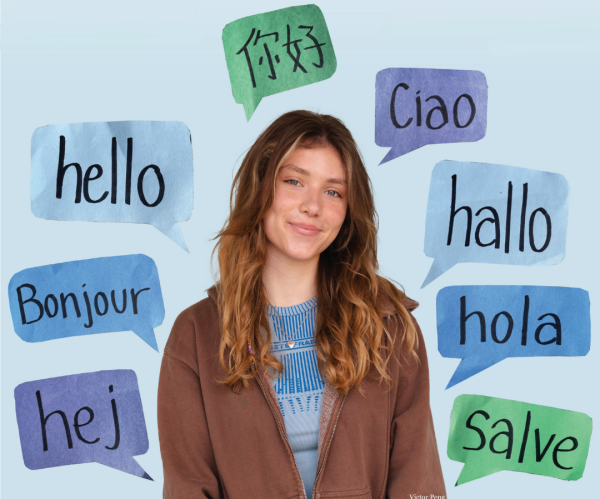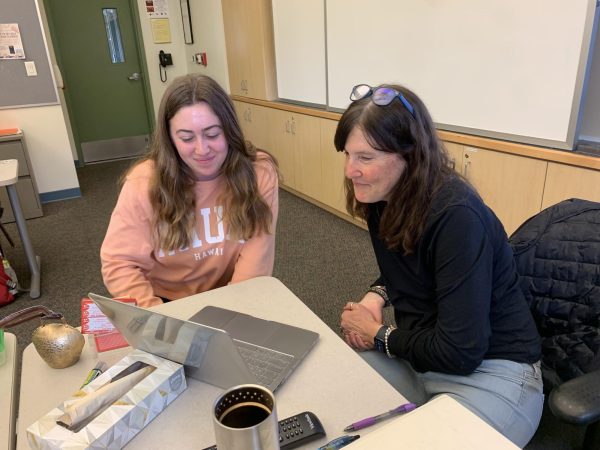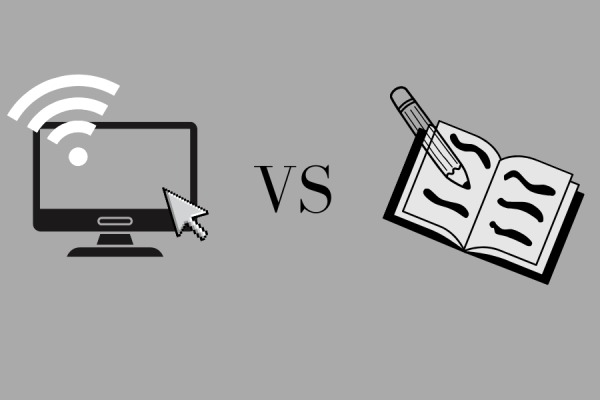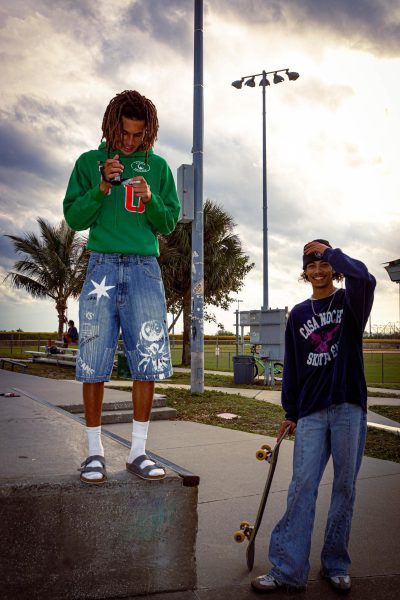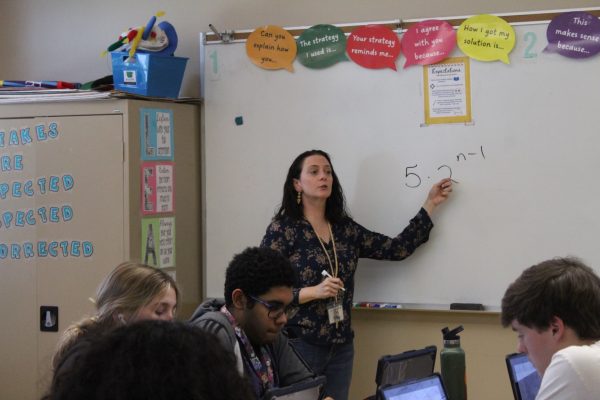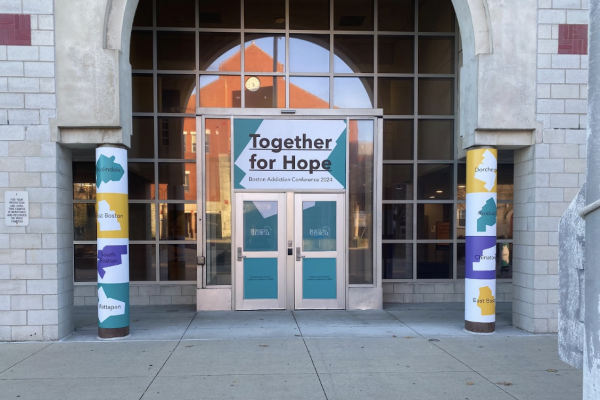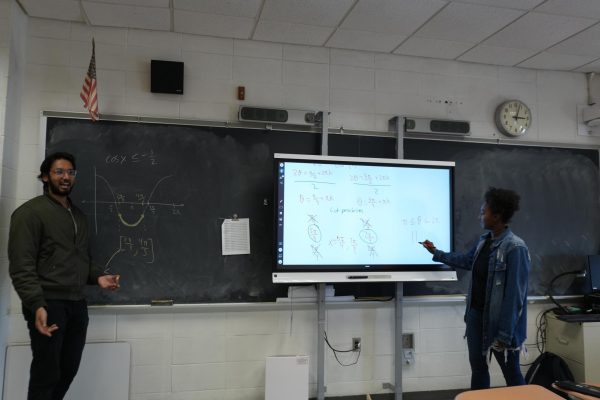Navigating the media terrain in the 21st century
Mishal Nizar
According to the National Association for Media Literacy Education, media literacy is “the ability to access, analyze, evaluate, create, and act using all forms of communication.”
April 30, 2021
Jan. 6, Washington D.C., the sight of the U.S. Capitol Insurrection. While the rioters who stormed the building that day were out trying to stop Congress from ratifying the 2020 presidential election, they also focused on another target: journalists.
“It scared me,” Illinois Press Association President Sam Fisher said. “Believe me, it did.”
When one walked the Capitol grounds on that day, they would find the phrase “murder the media” carved on the doors and mobs chanting at reporters to get out while smashing camera equipment.
“There are processes that people can go about to demonstrate opposition, but you can’t violently attack the institution, Fisher said. “You just can’t do that. January 6 was just not one day. It was a combination of many days.”
The attack on democracy is a threat to what was already amplified through social media platforms: media illiteracy. Unchecked sources and confirmation bias further drive a subconscious demand for content creators like journalists to tell consumers what and how to think instead of doing it for themselves. In addition, the rise of the digital age’s instant gratification mechanisms makes a thirty-second post feel like thirty minutes.
From print to digital: The rise of misinformation online
The digital age of the Internet came around in the late 1990s, but before that, there were physical newspapers. Sundays were for the paperboy to drop off the weekly scoop on all things news, sports, and reviews. They were the primary source of information on current events and crossword puzzles that took at least two cups of coffee to finish.
Picking up the newly printed edition of the suburban dailies, opinions and news were put in an orderly fashion with bolded sections. The brick wall between news and opinions was clear for the reader to recognize which articles were undeniably true rather than up for questioning.
The turn of the digital age, however, made reading a print newspaper a whole different ball game. It meant not reading a physical newspaper at all. The rise of digital media [such as photos, graphs, and video] leaves more opportunity for consumers to be engaged but also enhances the likelihood to subconsciously internalize information based on emotional appeal rather than the facts and evidence presented. A 2016 Stanford University study about finding credible sources concluded less than 20% of middle school students can distinguish between a news report and a sponsored story. In addition, less than one-third can identify implicit bias in an article they read.
Stanford’s 2016 study reinforces a change of what might literacy mean in the digital age. Naperville Central High School communication arts teacher and Central Times adviser Keith Carlson believes that being able to read and write is not a definition that can cover the entire terms of literacy such as media and news literacy.
“For someone to be considered literate no longer means that you can just read and write,” Carlson said. “That involves the ability to process the intense amount of information that we’re being fed through digital and multi-platforms, to be able to decipher that information and process it, and to make use of it.”
Although media illiteracy is becoming more common, organizations such as The National Association of Media Literacy Education [NAMLE] advocate for more media literacy awareness and offer literacy resources for the public. Media literacy is an umbrella term and can be used to associate with concepts related to the media, digital and print, as well as media technologies that are used to portray messages to an audience. Organizations such as NAMLE have a founding principle where the skills of media literacy are ultimate to “access, analyze, evaluate, create, and act using all forms of communication.”
For someone to be considered literate no longer means that you can just read and write. That involves the ability to process the intense amount of information that we’re being fed through digital and multi-platforms, to be able to decipher that information and process it, and to make use of it.”
— Central Times Adviser Keith Carlson
Kyle Plantz serves as NAMLE’s program assistant. He was a political reporter and did science reporting before working for NAMLE. He went into the journalism industry looking to create an impactful change and found media literacy as an opportunity to combine all of his interests with journalism and education. Through his experience as a reporter, Plantz realized some of the causes of media illiteracy.
“The decline of local news is a direct threat to democracy, because we’re seeing a lack of coverage of communities and holding people accountable for their decisions,” Plantz said. “We’re seeing local news outlets starting to decline, and they’re no longer in existence.”
News outlets such as The Washington Post, FOX, and CNN often focus on news that resonates with the entire country. One example includes the recent verdict of Derek Chauvin’s trial which followed the murder of George Floyd. His death continued to heighten the alarming increase of police brutality against Black people and minorities, which prompted the nation to push for police reform and justice. This includes a Minneapolis police practice investigation from the Department of Justice and legislative action regarding the George Floyd Justice in Policing Act. Monumental stories call for not only a local spotlight, but a national one as well. Although it is vital to view news at a broader scale, a key part of creating a country-wide change is to understand what is happening locally.
Since when did Aurora community members see coverage of the Aurora City Council elections or profiles about local changemakers on the New York Times? It is on local papers like the Aurora Beacon or Daily Herald that keep the community in the know. However, local journalism is declining due to budget cuts and layoffs, which makes it more difficult to cover every corner and beat of the community.
“There are whole areas of this country that don’t have anyone speaking for the people — but also, no one is holding people accountable, and without that, what is filling that place and we’re seeing a lot of propaganda sites pop up,” Plantz said. “People that are not journalists are claiming to be [professional] journalists and just pushing you to know one narrative or funded by people that have political intentions to spew certain types of information. That is a major issue and I think is a major reason why we are where we are today.”
Organizations such as NAMLE, MediaWise, and News Literacy Project are some of the many groups that create initiatives to promote media literacy to the public. It may seem simple to obtain those skills, but those organizations are only a small part of becoming media literate. The other parts are dependent on the consumer and the content creators.
One of the other main proponents of media illiteracy is social media. From Facebook to Instagram, instant gratification overrules obtaining a critical viewpoint.
“Sometimes it’s just really easy to not double-check what you’re saying,” senior Lavannya Deolalikar said. “You know to scroll on Instagram, you see something, and you’re like, ‘Oh yeah, I could look into this, but do I really want to [fact check] when there’s just another post just waiting below this one?’”
Social media is not the only driving force of creating a world of misinformation and disinformation. Other entities include corporate interests in mainstream media, such as broadcast news, along with digital and print newspapers. Metea 2019 alumnus Dhrtvan Sherman is a sophomore at UW-Madison and studies political science and public policy. He mentions his personal experiences with gathering news about politics while noticing the pitfalls of the journalism industry.
“I think journalists are failing, and it’s not because it’s their fault,” Sherman said. “It’s just the structure of the media. We have a system where corporate interest is what drives journalism. When’s the last time you’ve seen a big mainstream media source owned by someone in the working class? It’s not possible.”
When one runs a newspaper as a for-profit, the debate of compromising journalism ethics arises. One main issue at hand is the blurred line between entertainment and hard news — and how institutions, including media corporations with primary and secondary education systems, emphasize media literacy. It is up to journalists, creators, and consumers to discern factual information versus misinformation and to uphold the ethical basis of curating content.
What’s old is new: Partisanship in the news
Media illiteracy and unethical journalistic practices are not new topics in U.S. history. Writers and companies have manipulated information to entertain, persuade, and also confuse their readers. Take yellow journalism, sensational reporting, in the 1890s as an example; with the head-on competition between New York City newspaper publishers Joseph Pulitzer and William Randolph Hearst, it left a new era of sensationalist and melodramatic styles of journalistic entertainment and business strategy.
“If you look back into yellow journalism, and then the history of it, it was wild and crazy back then. It was social media,” North Central College Associate Professor of Journalism and Adviser to The Chronicle Dr. Mary O’Donnell said. “That was early social media: just salacious scandalous, no facts — everything made up for.”
Technology researcher Alexandra Samuel describes the inner workings of yellow journalism and, later, tabloid journalism in the early 20th century. Joseph Patrick McKerns’ “History of American Journalism” from 1976 additionally notes the justification of the First Amendment rights during the period.
According to McKerns, “To its many critics, it seemed as though the press was using the freedom from regulation it enjoyed under the First Amendment to make money instead of using it to fulfill its vital role as an independent source of information in a democracy.”
Following the critique of sensationalized journalism, the attributed success of the New York Times shifted from the decline of yellow journalism and became a “highly conservative paper” according to Sidney Pomerantz regarding the New York Press. The courts also had the same sentiment as the public. As Amy Gajda, a law professor at Tulane University points out in “Judging Journalism,” the courts concluded in holding newspapers and media outlets accountable relating to undermining the provisions of the First Amendment.
If you look back into yellow journalism, and then the history of it, it was wild and crazy back then. That was early social media: just salacious scandalous, no facts — everything made up for.
— North Central College Associate Professor of Journalism and Adviser to The Chronicle Dr. Mary O’Donnell
The early 20th century continued to see another check on yellow journalism. W.E. Miller established the journalism industry’s first code of ethics in 1910. This was then adopted by the Kansas State Editorial Association. The success and adoption of similar codes across the country was only the beginning of combatting a long-standing tension between public interest and sales versus accurate reporting. This results in creating a culture of clickbait and prioritizing human interest stories rather than hard news.
Questioning the media is not new, however. The Donald Trump presidency only exacerbated the hyperpartisanship attitudes and political polarization on the news and how humans practice civil discourse.
On Feb. 18, 2017, former President Trump incited a formal declaration of war against the media on Twitter. Trump declared ABC, CBS, CNN, NBC, and the New York Times as “FAKE NEWS media” and mentioned that the news media is “not the enemy of my people, it is the enemy of the American People.”
From Woodrow Wilson’s creation of the Committee on Public Information to Nixon’s work on Fairness Doctrine to the Obama administration targeting former New York Times reporter James Risen with a subpoena to reveal confidential sources, Trump was not the first U.S. President to engage in tension with the news media. As Trump continued his administrative agenda, he repeatedly used the phrases “fake news” and “enemy of the people.” Regardless of political affiliation, those statements became a part of the American culture. It became part of the United States’ social culture.
“I think that the term ‘journalist’ has lost a little of its professionalism as social media has allowed the acts of journalists to become more community-owned and not professional,” Naperville Central’s Carlson said. “I think that’s part of your problem and where Trump comes in. He commandeers the concept of fake news and basically turns it into ‘fake news is weaponized journalism where media outlets say things that could harm or hurt me. And it doesn’t matter if the things that are being said are 100% factual, it’s meant as an attack on my party or me.’”
The scoop of digital and print journalism
Papers have had a history of channeling misinformation. The first thing to note: there are different types of newspapers such as entertainment, watchdog, and investigative journalism at the local and corporate level. Popular newspapers and broadcast media include ABC World News and The Washington Post.
North Central College’s O’Donnell notes that there was a time where networks such as ABC, CBS, and NBC lead the evening news. Viewers would receive information that they knew was credible and had all the same stories but each in a different tone.
Opinionated segments would be given towards the end which gave the viewers a clear distinction between hard news and commentary. Regarding politics and political campaigns, the Fairness Doctrine would also apply in newspapers, where an equal-length story with the same sized photo, headline, and word count would be present, hopefully also written in the same tone.
Metea Valley Stampede’s 2016 Editor-in-Chief, Turner Smith, believes that although newspapers and broadcasts work to find truth and report the facts, most of them are also for-profit. This means having an agenda, such as selling subscriptions or picking what caters to their audience.
Smith also believes that journalists will have personal beliefs and their own ways on how to go about the story. However, journalists are encouraged to be intentional in what they are creating and to amplify the voices of as many sides as possible. Those who intentionally use their biases and constantly reinforce the same beliefs do not contribute to diversifying the story and can easily become an unintentional opinion piece.
“The best thing that we can do is just diversify our viewpoints,” Smith said. “I don’t think it’s so much about saying ‘okay I’ve pulled the facts out, and I’ve identified which part is commentary.’ Even if you could do that, which is remarkably difficult to do a lot of time, I don’t think that’s the long answer. I think the answer is to get as many different pieces of commentary as we can, and then to be informed as that will make you, and then decide, you know, what is accurate.”
I think the answer is to get as many different pieces of commentary as we can, and then to be informed as that will make you, and then decide, you know, what is accurate.
— 2016 Stampede Editor-in-Chief Turner Smith
With a driven agenda, there is also a debate of whether or not consumers should trust news outlets, with the continuing presence of corporate incentivized interests. Assistant Professor in the Department of Political Science at the University of Illinois at Chicago, Dr. E.J. Fagan, notes that the news media chooses news based on what people are willing to tune in for. He emphasizes that viewers look for conflict and debate, especially on national television. Although there seems to be more aggression, there is still an agreement between people in power.
“You know there is more conflict than ever, but there’s still agreement kind of underneath that surface,” Fagan said. “That’s why I encourage people to look at elite policy communities because there is a lot more agreement there than you often see otherwise.”
Now, how trustworthy would the reporting be if the large news media companies are corporately incentivized and are able to make damaging mistakes? One example is the defamation lawsuit against The Washington Post and CNN by 2020 Covington Catholic alum Nick Sandmann. The lawsuit was in light of the face-to-face confrontation between Sandmann and Native American protestors on the Lincoln Memorial in Jan. 2019. News outlets began painting Sandmann and his classmates as instigators, while Sandmann said he was attempting to diffuse the situation.
“They did agree that they had overstepped their characterization of [Sandmann],” O’Donnell said. “So that shows you that even the big [journalists] of the news industry can make a misstep… [Journalism] is a crucial public service, so maybe if we were better at emphasizing that and reminding people that out of that whole newspaper there are a few errors in there, but there are 1,000 correct things too. When you do get hit with something, you have to acknowledge it and try to do better, very openly, honestly, and transparently.”
What about social media? Is it a form of journalism? There are mixed opinions since the digital age also falls on the emergence of social media. It is a way to communicate information or the latest stories. Whether it is a form of journalism, however, is up for debate.
Tapping into social media
The current prevalence of social media enables more autonomy to curate content and become self-proclaimed journalists. Although it pushes for movement and change, it also magnifies the odds of misinformation and can replace traditional journalism. The reliance on social media rather than traditional journalism is also enabling those in power to use “post-truth amounts to form ideological supremacy” and serving their interests, as Lee McIntyre notes in “Post-Truth.”
“I am a big proponent of free speech, but this is not what social media offers,” O’Donnell said. “You know, there’s free speech. However, an average citizen can’t go into a theater and yell out the word ‘fire,’ if it means people get harmed. There is a civil Supreme Court case that says you cannot. That’s the line when you’re inciting harm.”
As social media can be a form of journalism, O’Donnell and Smith agree that social media provides a “wild west” connotation, in which an average consumer might have trouble understanding the difference between a verified and unverified source.
“[Social media posts] are bite-sized. They’re quick. They’re digestible. They say what you want to say better than you might be able to put it into words,” Smith said. “And it confirms what you already believe, and it’s so easy to just retweet it, and so we do that without even thinking about it, really.”
Spanning from high school to college, politically and civically active students such as Events and Communications Director for Citizens of Metea Nethra Yuvaraj find their initial exposure of information through social media.
“I get a lot of my information today about politics just from social media,” Yuvaraj said. “But I also think that I also get misguided a lot from social media, because sometimes I’ll see like a headline or tweet or something that somebody reposts in their story. And then when I go to repost it somebody will text me like, ‘hey that’s false information.’ So I definitely do think social media is a form of journalism, I just don’t know how credible it is.”
In addition to Yuvaraj, Metea 2018 alumna Alexa Jordan struggles to sift through the news media and realizes her attitude as a media consumer has changed throughout her life.
“When I grew up, CNN was, like, my favorite thing to do after school,” Jordan said. “I would quickly run to my computer to watch ‘CNN Student News.’ I would spend hours every day reading through news stories, and, of course, I still read new stories now, but I always need to take things that I read from basically any new source, now with a grain of salt.”
Part of navigating through the media terrain also involves the way social media algorithms work, therefore making it easier to seek confirmation bias.
“One problem is, by doing that, we just create this massive echo chamber,” Smith said. “You’re never getting a diversity of opinion, but the other problem is, a lot of times, it’s just not right, like, it’s just not true. It’s just something that somebody whipped up on Microsoft Paint or whatever. And that’s why companies like PolitiFact, a news fact-checker website, are starting to become such an important piece.”
However, Naperville Central’s Carlson believes that it is important to destigmatize social media as a negative tool. Instead, Carlson works with his classes and deciphers media messages through strategies such as the 80/20 rule and the five questions he asks his students.
“While I appreciate a protective parent who is keeping their child from having a stupid mistake on the internet, I also see a child who will become an adult and have no concept of how to use social media properly,” Carlson said. “Let’s train students how to use it properly, instead of making it into the devil and convincing everyone how bad it is because you know that type doesn’t help us learn anything about it.
“Make America think again:” Fostering intentional education
Implementing media literacy curricula and understanding society’s civic duty are the main components that need to be emphasized within the education system to better equip students to navigate through the media terrain. Nolan Higdon and Mickey Huff’s “United States of Distraction” notes the “Five Cs” to ensure a “self-governing and free society”— civics education, critical thinking, critical awareness of media, cultural competency, and community engagement.
The Illinois Press Association’s Sam Fisher is one to understand that civic engagement and education, especially, are of the utmost importance when part of the journalistic process.
“Knowledge of civics and participation in government is huge,” Fisher said. “It’s paramount. You know, it’s the heart and soul of democracy. We had an [recent and local] election; in my particular area, the voter turnout was not very good, and that’s disappointing. I think part of media literacy is getting people to care about the real issues and to understand what the real issues are.”
One student in particular took it upon himself to initiate change in the Illinois Legislature. The Central Times’ Columnist Writer, Braden Hajer, was working on a capstone project for his class. His ideas further helped propel a once dead media literacy bill back into the House Committee of the Illinois State Legislature.
“What I ultimately decided was, [media illiteracy] probably [exists] because no one knows anything about how to combat misinformation because, by design, you don’t know when you’re being misled,” Hajer said. “And that’s where the legislation idea comes in.”
The legislation, House Bill 0234, amends the School Code to implement a media literacy curriculum in public schools. Rep. Elizabeth Hernandez, the lead sponsor of the bill, presented the bill at the recent Elementary & Secondary Education: School Curriculum & Policies Committee on March 24.
“I think that all people, young and old, need to start being trained in understanding media literacy,” Chief Co-Sponsor Rep. Stephanie A. Kifowit said. “I think we’re losing the ability to see things from a different point of view because if people just isolate themselves and what’s been called the bottle, and they only isolate themselves with people of the same mindset, there’s no healthy exchange of ideas which I think is very important.”
Concerns were made regarding the unfunded mandate the bill causes from Rep. Daniel Swanson. The success of implementing an additional requirement for the academic school year and confusion upon allowing mandates sponsored by the Illinois State Board of Education were also brought up by Rep. Avery Bourne and Tony McCombie respectively. The bill was then scheduled for third reading after the committee session. It was passed in Illinois House 66-44 on April 20.
Rep. Swanson, Bourne, and McCombie, who all voted against the bill in committee, did not respond to requests for comment.
In addition to Rep. Bourne’s concern, most of the work to implement media literacy is already embedded in general education classes. In NAMLE’s Kyle Plantz view, there just needs to be more of an emphasis on media literacy in particular.
“We’d like to see the focus of media literacy where it’s not something additional that teachers have to do,” Plantz said. “It’s just something that they’re currently already doing- but they can be more either explicit about it, or have more understanding about good media literacy practices that they can incorporate into the classroom.”
Specifically, STEM classes, impact scientific reasoning and mathematics regarding what consumers are interpreting with charts, graphs, and scientific or mathematical explanations online. Math Department Chair Jacqueline Palmquist explains that skills from earlier courses in high school offer the foundational skills to apply in informational math and statistics.
“To me, a lot of that rings true in math in terms of statistics,” Palmquist said. “When it’s out in the media and if someone says you have a 97% chance of you to do this, there’s a lot that goes before that, and if you don’t kind of digest it with a critical lens of how is that true. Why is that true? Who did they study, what did they study? You are believing truths and non-truths and making judgment calls on what was pushed out to you, without you actually digesting it yourself and thinking about it yourself.”
Despite the passage of the bill to mandate media literacy, Naperville Central’s Carlson believes that it is important to be intentional about the implementation. He notes that educational mandates such as the bus safety protocol and district Chromebook user agreements are important. It is quick to go through and not give in much thought. However, Carlson thinks that a mandate such as administering media literacy practices should be handled otherwise.
“That’s kind of how we treat digital citizenship right now and that’s how we treat media literacy,” Carlson said. “It’s like ‘hey you’re aware of this right? Yes, now let me have my stuff,’ and that’s kind of how we’re handling it. So, I think the problem right now is not an awareness of [media literacy]. It’s implementing it in a way that’s really meaningful and there are some things that we could do that I don’t think would be super painful….We’re not doing well enough when it comes to connecting the message with implementing the message.”
Understanding the journalistic process outside of the classroom is also vital to becoming media literate. It does not mean that every student has to be on their high school yearbook, broadcast, or newspaper staff. However, when the opportunity arises, it can lead to better processing what it is like to be entrusted with a writing platform.
2016 Stampede’s Smith realized that the published articles about the 2016 U.S. Presidential Election were an indicator that the staff was doing their job regardless of the criticism from both aisles they received. Through this, Smith acknowledged that any “healthy news source” will have critics from all sides, but it does not automatically mean that they are untrustworthy.
“I think it was really helpful for me to gain that experience, and understand that when I’m trying to evaluate a news source,” Smith said. “Remember what it’s like to try and put out the news. And give journalists the benefit of the doubt when you can, because you know that somebody is always going to be unhappy with the news source.”
“Make America think again:” Bring the beats back
As for transforming the way consumers receive information, Nolan Higdon and Mickey Huff’s book “United States of Distraction” encourages broadening news media framing, investing in local and investigative journalism, implementing educational news media in schools, and protecting whistleblowers.
Newstown, a documentary regarding the closing of the Youngstown Vindicator, suggests that the root of democracy is built upon a disappearing voice: the local newspaper. Local papers such as the Naperville Sun, Aurora Beacon-News, and the Daily Herald are some of the many publications that are facing increased financial burden. As newspapers go online, the local paper’s main source of revenue, advertisements, goes down. As a result, local newspapers are increasingly funded by private equity and hedge funds, which has resulted in local newspapers sold, traded, and closed as financial assets, rather than as an asset to the local community.
One of a firm’s ways to make money is facilitating a leveraged buyout. The firm buys a company like a newspaper by taking out a loan. The debt is not on the firm’s shoulders; it is on the newspaper publications. The newspaper is often stretched to maximize as much profit and repay the loan through budget cuts and layoffs. Eventually, if the newspaper goes bankrupt, the private equity firms are not responsible for it. Newspapers are also targets for vulture funds to sweep in and “bleed newspapers dry.” These vulture funds include Fortress Investment Group and Alden Global Capital. They are also notable for employee layoffs. It is not a newfound pattern, and the consequences are not new either.
“I know more local newspapers are going under, and that fate is going to continue because people want the information for free,” Naperville Sun Reporter Suzanne Baker said. “I can’t tell you how many times people will say, ‘Why are they making me pay for this? I shouldn’t have to pay for it.’ Well, yeah, you do. Go into a grocery store or restaurant and say, ‘Well, I want this, and I shouldn’t have to pay for it.’ News is gathered and it costs money for someone to gather that news and present it to you.”
Baker is one of many local reporters in the Naperville and Aurora area that are struggling to find the resources and security needed for their jobs, such as an office to work in. In addition, Baker is one of the few reporters that write for the suburban dailies, which means that there are not enough people to divide up the work and cover every beat of the city.
“All you’re seeing is this barrage of national news, and you think that’s the only thing happening,” Baker said. “And I think [that] kind of contributed to some of the things that we’re seeing in society today because people only see the scary parts of what’s going on, even though it’s not anywhere near them. They’re not hearing all the good little things that their little communities are doing and the people in their community are doing, or [that] there’s no one to watch over their government.”
In addition, the absence of local journalism has enabled consumers to utilize other media technologies and publishers such as Facebook or Twitter as their prime news source. Areas without local journalists are not able to keep elected officials and institutions in check. This eventually leads to polarizing viewpoints and a dependence on journalists telling their consumers what they should think.
North Central’s O’Donnell specifically encourages revamping local news media and investigative journalism. One way to do that is to encourage young people to get involved and understand the journalistic process.
“…When you graduate from college, you [should] get two years of your loans forgiven if you go into your local community and work at the newspaper,” O’Donnell said. “Get people who do that work, who are young and earnest, and need the experience.”
Two-way street: Establishing a media literate society
Along with investments in the education and journalism industry, there is still work to do, especially for publications, to evaluate their work as responsible journalists.
Metea Valley’s Yearbook Adviser, Kristen DiGiorgio-Kadich, became immersed with the idea of media literacy in her undergraduate years and her time advising Broadcast and Newspaper before Yearbook. Through her time practicing her craft, she has come to her beliefs of the journalism industry.
“I truly, in my heart of hearts, think that no journalist ever goes into journalism to create controversy or fake news,” DiGiorgio-Kadich said. “They truly go into it to seek truth and report it, and, somewhere along the lines, these big media conglomerates get more focused on ratings than they do reporting.”
Any effort to provide journalists the platform to “seek the truth and report it” comes at a standard of ethical practices. The standard guidelines are included in the Society of Professional Journalists Code of Ethics.
“I think if we look back, you know, in our publications, we have specific policies that we write,” DiGiorgio-Kadich said. “And we uphold our staff to those policies. I think the media outlets need to do a better job examining their policies and holding up their end of the bargain with their responsibility with responsible, ethical, and truthful journalism.”
The lessons from yellow journalism and the creation of ethical guidelines are not the sole solutions to curing the United State’s divisiveness in social, political, and ethical issues. With the growing popularity of self-proclaimed journalists online, there is a diminishing understanding of what makes up a professional journalist and the journalistic process. That is the reason why media illiteracy exists, why confirmation bias exists, and why a divided nation exists.
“[Being media literate] is on us to make sure that we’re getting to the bottom of things and putting out information that’s true,” Smith said. “We just have to stop being so lazy and so willing to accept things just because it’s what we want to hear, and to ask ourselves hard questions; because if we can do that, then that solves 99% of the problem.”
This story was originally published on Metea Media on April 29, 2021.



























![IN THE SPOTLIGHT: Junior Zalie Mann performs “I Love to Cry at Weddings,” an ensemble piece from the fall musical Sweet Charity, to prospective students during the Fine Arts Showcase on Wednesday, Nov. 8. The showcase is a compilation of performances and demonstrations from each fine arts strand offered at McCallum. This show is put on so that prospective students can see if they are interested in joining an academy or major.
Sweet Charity originally ran the weekends of Sept. 28 and Oct. 8, but made a comeback for the Fine Arts Showcase.
“[Being at the front in the spotlight] is my favorite part of the whole dance, so I was super happy to be on stage performing and smiling at the audience,” Mann said.
Mann performed in both the musical theatre performance and dance excerpt “Ethereal,” a contemporary piece choreographed by the new dance director Terrance Carson, in the showcase. With also being a dance ambassador, Mann got to talk about what MAC dance is, her experience and answer any questions the aspiring arts majors and their parents may have.
Caption by Maya Tackett.](https://bestofsno.com/wp-content/uploads/2024/02/53321803427_47cd17fe70_o-1-1200x800.jpg)
![SPREADING THE JOY: Sophomore Chim Becker poses with sophomores Cozbi Sims and Lou Davidson while manning a table at the Hispanic Heritage treat day during lunch of Sept 28. Becker is a part of the students of color alliance, who put together the activity to raise money for their club.
“It [the stand] was really fun because McCallum has a lot of latino kids,” Becker said. “And I think it was nice that I could share the stuff that I usually just have at home with people who have never tried it before.”
Becker recognizes the importance of celebrating Hispanic heritage at Mac.
“I think its important to celebrate,” Becker said. “Because our culture is awesome and super cool, and everybody should be able to learn about other cultures of the world.”
Caption by JoJo Barnard.](https://bestofsno.com/wp-content/uploads/2024/01/53221601352_4127a81c41_o-1200x675.jpg)





